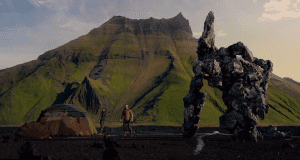 Noah has been out on Blu-Ray for over a week now, and new interviews with the filmmakers are popping up here and there. The Chicago Sun-Times has a new interview with Ben Snow, who oversaw the visual effects on the film, so I figured I might as well create an “interview round-up” for the visual-effects artists similar to the round-ups I’ve already created for director Darren Aronofsky, co-writer Ari Handel (updated today!) and cinematographer Matthew Libatique.
Noah has been out on Blu-Ray for over a week now, and new interviews with the filmmakers are popping up here and there. The Chicago Sun-Times has a new interview with Ben Snow, who oversaw the visual effects on the film, so I figured I might as well create an “interview round-up” for the visual-effects artists similar to the round-ups I’ve already created for director Darren Aronofsky, co-writer Ari Handel (updated today!) and cinematographer Matthew Libatique.
Snow talks about how it all started with Aronofsky and Handel’s screenplay, which came with “a whole bunch of inspirational imagery,” and he discusses the ideas behind the effects both small — such as adding stars to the skies in the daytime shots — and big, such as the “rock monsters” (actually fallen angels encased in rock):
Q. What about those giant stone Watchers?
A. We’d done some speculative design work on them. They were like giants with multiple arms. We sat down and talked about large creatures in films from the last 10 to 20 years [such as “The Transformers” films]. We had a particular one we liked [from “Snow White and the Huntsman”], that I thought was particularly nicely done. But Darren wanted something that was quite unique from anything else.Q. In essence you gave them personalities.
A. Yes. Why did they feel the way they did? They were these divine creatures who were elegant and graceful and they came to earth and got trapped in these stone bodies. … We looked at videos of people with severe leg injuries and how they overcame them. The goal was to try and reflect some of that struggle and triumph [in the Watchers].
Regarding the computer-generated animals, he says:
Technically, positioning the animals was an enormous challenge. There are so many of them! We had 13,000 separate animals, two by two; every pair was different. A lot of them were hand-animated. Darren’s idea of a “big shot” is not really epic unless its 20 seconds; nowadays five seconds is the average and in action films it’s maybe three seconds. The sheer organization of that one shot of them all entering the ark — they’re not real, and in reality all these animals would not work together. There are computer programs for crowd simulators, where you have these hordes of humans for big battle scenes and so forth. We actually ended up using the software in the end.
Also, in a recent interview with Examiner.com, Snow talked about what it was like to work with Aronofsky:
How was your collaborative process with Darren Aronofsky? I’m sure he had no shortage of ideas.
No, he absolutely didn’t, and he’s someone who, as an artist, really tries to draw ideas out of the team he is working with as well. He has very clear vision, and he told me that he also wants to be sure he’s getting the strongest vision he can out of his collaborators. He demands that you push back, he demands that you have ideas. It’s interesting to get to work with that, because on one hand, he’s emphatic about what he did or didn’t like, but on the other hand, he’d say “I’ll tell you when I don’t like something, but I want you to put the ideas out there.” It was very satisfying from that point of view. It’s interesting because some people find that very exciting and stimulating, and I certainly did and most of my team did. That was one of the unique and fresh things about the project, an opportunity to try and be creative with things and to try things that are a little different from what we’ve tried before.
The thinking behind the film’s visual effects has come up in a number of my posts, but I’ve never gathered them together all in one place. So, just for ease of reference:
Aronofsky talked about how one of the animal shots in this film was the most complicated shot in ILM’s history, and how he made the decision to rely on digital animals for ethical and practical reasons. Snow also talked about how the effects team studied extinct animals, and how the studio requested that the menagerie include some pachyderms so that audiences would have something they could “latch on to”.
One story published at the time of the film’s release looked at how one company — Look Effects — delivered over 300 shots for the film, which was “by far” the largest project the company had undertaken in its 16-year history. Another story looked at how that very same company lost a lot of money on the film because it took much longer to create their shots than they had originally anticipated.
A press release issued by Technicolor-PostWorks New York back in May noted that the film’s complex visuals, including its many effects shots, “made it the largest feature film post production project ever undertaken in New York.”
Finally, some featurettes on the film’s visual effects were of course included on the Blu-Ray editions of the film that came out last week. You can watch some clips from those featurettes here, and read my thoughts on the featurettes here.
December 5 update: I added a new interview with Snow to my post on the movie’s Oscar buzz. Alas, the movie did not make the visual-effects shortlist in the end.
February 4 update: Industrial Light & Magic released a new video on the movie’s effects, presumably because the Visual Effects Society awards are tonight:












